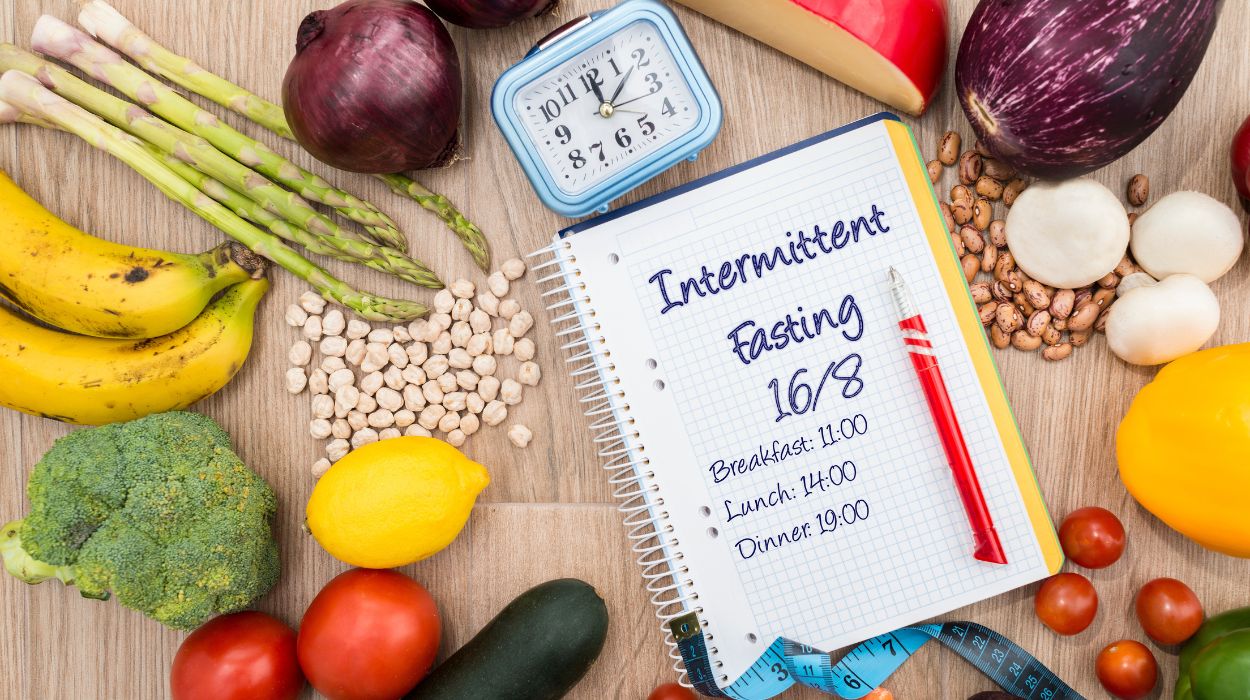 Expert's opinion
Expert's opinion
Expert's opinion
The article is a subjective view on this topic written by writers specializing in medical writing.
It may reflect on a personal journey surrounding struggles with an illness or medical condition, involve product comparisons, diet considerations, or other health-related opinions.
Although the view is entirely that of the writer, it is based on academic experiences and scientific research they have conducted; it is fact-checked by a team of degreed medical experts, and validated by sources attached to the article.
The numbers in parenthesis (1,2,3) will take you to clickable links to related scientific papers.
How Many Calories To Eat During Intermittent Fasting 16/8 2024?

What’s the best way to lose weight without counting calories? Many find tons of success after giving intermittent fasting a try—that is, choosing a substantial portion of each day during which they vow not to eat a crumb. It might sound extreme to some, but it’s one of the best ways to manage your body weight intuitively.
Some consider a 16-hour fasting window ideal, giving your body plenty of time to process your food between each intake period. This diet is called the 16:8 diet, and it will likely have a significantly positive impact on your weight, blood sugar, and overall health.
Is 16:8 intermittent fasting dangerous? What’s the best meal plan to choose when giving this lifestyle a shot? Burning body fat on this diet isn’t difficult, especially once you’re familiar with the rules of the game.
How Many Calories To Eat During Intermittent Fasting 16/8?
The FDA recommends[1] 2,400 to 2,800 calories a day for men and 1,800 to 2,200 calories a day for women. Both of these daily caloric goals can help you lose weight—some find that time-restricted eating helps them remain in a deficit daily by cutting them off at a time when they would normally continue eating. Without your usual late-night snack, you might find yourself with much more wiggle room than usual.
How Many Calories To Eat During Intermittent Fasting 16/8?
For the math geeks out there (meant in a good way!), weight loss occurs with a 10-20% reduction in calories consumed compared to what your resting metabolic rate (RMR) requires. Your BMR is the amount of energy you need at rest–to run your circulation, breathing, and metabolic processes, which is why exercise is so good for dieting because you’re burning over and beyond what you need at rest.
Males: RMR (calories) = 9.99 x weight (in kg) x height (in cm) – 4.92 x age +5
Females: RMR (calories) = 9.99 x weight (in kg) x height (in cm) – 4.92 x age –161
Next, multiply your computed RMR by your activity level (1.2–sedentary; 1.375–light exercise; 1.55–moderate exercise lifestyle; 1.725 hard exercise lifestyle; and 1.9–extra active, e.g., physical job or training). These formulas aren’t just for the 16:8 method–they work for all diets.
Thus, RMR x activity level – 10-20% = weight loss.
For those of you who aren’t into all the math, the FDA recommends[1] 2,400 to 2,800 calories a day for men and 1,800 to 2,200 calories a day for women. Both of these daily caloric goals can help you lose weight—some find that time-restricted eating helps them remain in a deficit daily by cutting them off at a time when they would normally continue eating. Without your usual late-night snack, you might find yourself with much more wiggle room than usual.
What Is The 16:8 Diet?

To lose weight in any diet, there should be a 10-20% reduction in calories consumed compared to calories burned. The math is a little complicated, as explained below, but represents a useful simplification.
Intermittent fasting is one of the most popular ways to diet–to stay slim, improve gut health, and prevent underlying health conditions later on in life. Many diets in this family go by monikers that indicate how long each eating window and fasting window lasts.
One of the most popular is the 16:8 intermittent fasting plan. The “16” refers to the 16 hours a day in which you’re asked to avoid eating, including your overnight sleep time. The remaining 8, your allowable eating time period, acts as your feeding window. You’re able to choose your own adventure, choosing the whole grains, lean protein, and healthy fats that you like during this time.
The best part about 16:8 intermittent fasting is that it can be adapted to any type of lifestyle. If you prefer to skip breakfast in the morning, you might start your eating day at lunch, giving you until 8 pm that evening to eat. Some instead choose an early supper around 3 pm or 4 pm—it all depends on what you prefer and what fits around your professional, familial, and social responsibilities. For those who work unusual work shifts, the 16:8 method is ideal, as it can be shifted according to the circadian rhythm your work requires.
In a general sense, on this diet, there is no need[2] to eat fewer calories than you would otherwise, especially if you already operate on a calorie deficit ordinarily. Many of the health benefits associated with intermittent fasting and weight loss have more to do with the period of peace that each fast treats your system to—more on that in a moment.
How Many Calories Break A Fast?
What can you eat and drink during your fasting period? Ideally, nothing aside from water, calorie-free tea, and things of that ilk, although many experts permit the consumption of things like bone broth and pure fruit and vegetable juices while still getting used to this regimen.
If you’re in it to win it, the reality is that any amount of caloric energy should be considered fast-breaking. It might sound extreme if you’re used to eating whenever you like, but biologically, a true fast is the most effective type of fast for weight loss. In this sense, fasting is an all-or-none proposition: you’re either fasting or you’re not.
If you struggle to stay occupied and focused between eating periods, you’re not alone. Chewing sugar-free gum is one tip for fledgling fasters—if you prefer to avoid the tactile association, however, another great piece of advice is to stay as busy as possible during your non-eating windows.
Chores, hobbies, and even a good movie are all perfect for when you’re stuck at home, watching the clock. If you’re fasting at work, stay as hydrated as possible; sometimes, even something as simple as a ten-minute walk around the block might be all that you need to improve your resolve at your desk.
A burst of activity like this will shunt your blood flow in favor of your muscles and lung capacity, shunting it away from your digestive system; this will decrease your appetite. Exercise “intervention,” besides being a good distraction away from eating, improves short-term appetite control, possibly by releasing satiety peptides in the body[3]. Ghrelin, a peptide that stimulates the appetite, is higher in those with a sedentary lifestyle[4].
While plain coffee with no cream or sugar is permitted while fasting, you should avoid drinking beverages with calories once you’ve truly found your wings. There will be plenty of time to eat when the appropriate time comes.
What To Eat During 16:8 Intermittent Fasting To Lose Weight
The best way to eat during your feeding period is intuitively and in line with your lifestyle and intrinsic needs. A balanced diet looks totally different for different people—if you’re extremely active, you should avoid restricting calories during your feeding window. Eat food that feels right, and try not to overindulge just because the clock is ticking down.
In any case, you should spend your day consuming feel-good meals composed of whole foods. If you prefer to count calories, you can use a meal-planning app like Chronometer or MyFitnessPal to configure all of your favorite ingredients for each meal within your daily goals.
Our advice is to focus on eating hearty, wholesome, and sustaining meals, food that won’t leave you starving midway through your fast later. You should also make a deliberate point of staying adequately hydrated through both your fasting period and your eating period.
What’s on the menu? Some of our favorite ingredients include
- Complex carbs like brown rice, quinoa, and oatmeal
- Healthy fats like olive oil and coconut oil
- Lean proteins like grilled chicken, seafood, and perhaps the occasional steak
- Tons of healthy produce—greens, fruits, crucifers, and starchy vegetables like potatoes, yams, and corn
- Lighter sources of protein, like eggs, yogurt, and cottage cheese
- Any nuts and seeds that you enjoy, as well as other healthy snacks like dried fruit
When it comes to foods to avoid while intermittent fasting, it’ll be the same as with any healthy lifestyle. Candy, sugary beverages, fast food, fried food, convenience food, and other processed junk should all be left off of the table if you’re serious about weight loss.
Keep in mind the timing advantages behind the 16:8 rationale that allows it to work for weight loss. High sugars play havoc with your insulin levels and really muck up your normal appetite suppression mechanisms. Leptin, which blocks the drive to eat, is regulated by insulin[5], and high sugar can cause insulin to peak unnaturally. The idea behind the 16:8 design is to work with your circadian rhythm, not against it, and poor food choices can defeat its purpose.
Similarly, high-fat diets overcome the typical fat-induced satiety signals[6]. That is, a reasonable amount of fat in your diet allows you to be satisfied, but this mechanism breaks if you take in too much.
While diets like the 16:8 diet don’t necessarily call for calorie restriction, you could gain weight if you consistently choose meals and snacks that cause your calorie intake to balloon. You’ll likely end up feeling like crap, too.
Is 16:8 Intermittent Fasting Good For You?
A daily fasting period may be able to help you induce any of several weight-loss-friendly processes within the body—lipolysis, autophagy, and even ketosis[7] may all end up being a part of your weight loss plan by consequence. Intermittent fasting is also anti-inflammatory[8] and reduces oxidative stress[9] in pretty much every part of your body. Talk about a diet plan with benefits.
The benefits of intermittent fasting go far beyond weight loss, though. Aside from[10] being great for heart health, insulin resistance, low blood pressure, and low blood sugar, planning your diet plan under these terms can also prevent neurodegenerative disease and dysfunction[11] and might even be able to prevent malignant tumors[12] from forming.
Fasting in any capacity is extraordinarily beneficial for weight loss, as well. Intermittent fasting, in particular, has an extremely positive effect on the shift in body composition[13] that time-restricted fasting confers.
This means that the weight you lose is more likely to be fat stored; your body can burn fat more effectively while maintaining fat-free mass elsewhere. If you’re an athlete, intermittent fasting works with you, ensuring that your eating plan does not impose upon your athletic performance later on in the gym.
Is it difficult to get used to? Your first few days might be a drag, but it doesn’t take long to get the hang of it. Rules get easier to follow as times go on. Keep yourself busy and focus on how you feel—you might not be able to fight off a saber-tooth tiger-like your ancestors, but you might be inspired to pick up a meditation practice with all of your newfound energy.
The Health Benefits Of Intermittent Fasting Are Undeniable
Is intermittent fasting for everybody? It can be, even if you’re not so keen on the idea of a 16-hour fasting window. Our advice is to start small—this may include skipping out on your usual late-night treat.
People don’t grieve over the extra piece of cake they could have had a year ago; the challenge is to resist that piece of cake right now. If you can get through that moment, you won’t miss that particular piece of cake ever again. It might be a bummer at the moment, but we guarantee that you’ll wake up the following morning with a renewed sense of resolve.
Intermittent fasting for weight loss is awesome because you’ll often fall into a calorie deficit inadvertently, without counting calories like a crazy person. You’re able to eat what you want, and many find themselves empowered as they overcome previous eating disorders and other forms of disordered eating.
As your overall health improves and the fat loss that you achieve becomes more and more apparent, you might find that eating in this way becomes your new normal. It truly does get easier with practice, and your results will speak for themselves.
+ 13 sources
Health Canal avoids using tertiary references. We have strict sourcing guidelines and rely on peer-reviewed studies, academic researches from medical associations and institutions. To ensure the accuracy of articles in Health Canal, you can read more about the editorial process here
- Do You Know How Many Calories You Need? Estimated Daily Calorie Needs*. (n.d.). [online] Available at: https://www.fda.gov/media/112972/download.
- Mandal, S., Simmons, N., Awan, S., Chamari, K. and Ahmed, I. (2022). Intermittent fasting: eating by the clock for health and exercise performance. BMJ Open Sport & Exercise Medicine, [online] 8(1), p.e001206. Available at: https://www.ncbi.nlm.nih.gov/pmc/articles/PMC8744103/
- Martins, C., Morgan, L.M. and Truby, H. (2008). A review of the effects of exercise on appetite regulation: an obesity perspective. [online] 32(9), pp.1337–1347. doi:https://doi.org/10.1038/ijo.2008.98.
- Alireza Jahan-mihan, Magyari, P. and Pinkstaff, S.O. (2021). The Effect of Intensity of Exercise on Appetite and Food Intake Regulation in Post-Exercise Period: A Randomized Trial. Journal of Exercise and Nutrition, [online] 4(3). Available at: https://www.journalofexerciseandnutrition.com/index.php/JEN/article/view/95
- Melanson, K.J., Angelopoulos, T.J., Nguyen, V., Zukley, L., Lowndes, J. and Rippe, J.M. (2008). High-fructose corn syrup, energy intake, and appetite regulation. The American Journal of Clinical Nutrition, [online] 88(6), pp.1738S1744S. Available at: https://academic.oup.com/ajcn/article/88/6/1738S/4617109?login=true
- Blundell, J.E., Lawton, C.A., Cotton, J.P. and Jennifer Isabel Macdiarmid (1996). Control of Human Appetite: Implications for The Intake of Dietary Fat. [online] 16(1), pp.285–319. doi:https://doi.org/10.1146/annurev.nu.16.070196.001441.
- Jamshed, H., Beyl, R., Della Manna, D., Yang, E., Ravussin, E. and Peterson, C. (2019). Early Time-Restricted Feeding Improves 24-Hour Glucose Levels and Affects Markers of the Circadian Clock, Aging, and Autophagy in Humans. Nutrients, [online] 11(6), p.1234. Available at: https://pubmed.ncbi.nlm.nih.gov/31151228/
- Madkour, M., Hassan, R., Sherif, N., Awadallah, S., Serafi, A., Jahrami, H. and Faris, M. (2020). Modulation of Anti-Oxidant, Anti-Inflammatory and Metabolism-Controlling Genes Expressions by Ramadan Intermittent Fasting: A Prospective Observational Study. Current Developments in Nutrition, [online] 4(Supplement_2), pp.1265–1265. Available at: https://academic.oup.com/cdn/article/4/Supplement_2/1265/5845651?login=tru
- Collier, R. (2013). Intermittent fasting: the science of going without. [online] 185(9), pp.E363–E364. doi:https://doi.org/10.1503/cmaj.109-4451.
- Anton, S.D., Moehl, K., Donahoo, W.T., Marosi, K., Lee, S.A., Mainous, A.G., Leeuwenburgh, C. and Mattson, M.P. (2017). Flipping the Metabolic Switch: Understanding and Applying the Health Benefits of Fasting. Obesity, [online] 26(2), pp.254–268. Available at: https://www.ncbi.nlm.nih.gov/pmc/articles/PMC5783752/
- Phillips (2019). Fasting as a Therapy in Neurological Disease. Nutrients, [online] 11(10), p.2501. Available at: https://pubmed.ncbi.nlm.nih.gov/31627405/
- Clifton, K., Ma, C.X., Fontana, L. and Peterson, L.L. (2021). Intermittent fasting in the prevention and treatment of cancer. [online] 71(6), pp.527–546. doi:https://doi.org/10.3322/caac.21694.
- Tovar, A.P., Richardson, C.E., Keim, N.L., Van Loan, M.D., Davis, B.A. and Casazza, G.A. (2021). Four Weeks of 16/8 Time Restrictive Feeding in Endurance Trained Male Runners Decreases Fat Mass, without Affecting Exercise Performance. Nutrients, [online] 13(9), p.2941. Available at: https://pubmed.ncbi.nlm.nih.gov/34578819/



